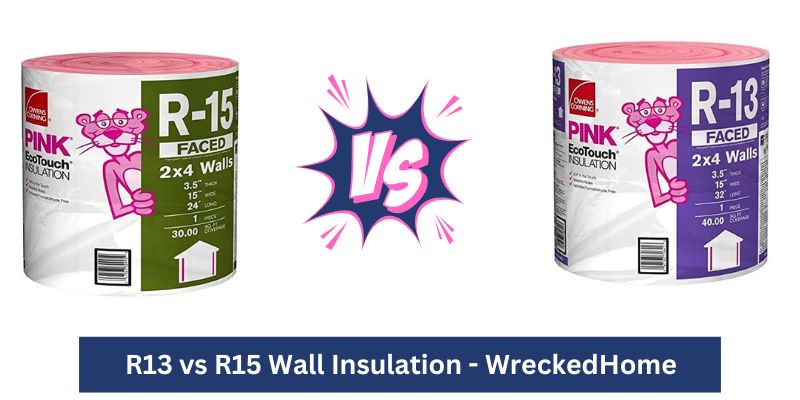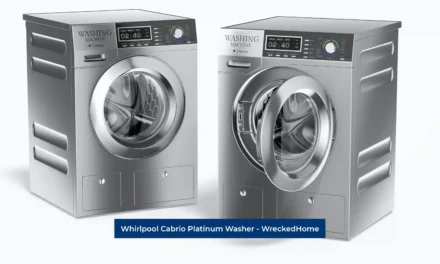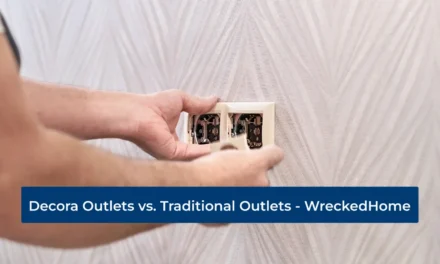Home insulation keeps the space warm in winter and cold in summer, but many homeowners are ignorant of the right type of insulation that is perfect for them. There are many varieties of insulation out there, but R13 vs R15 wall insulations have a special place. The R-value of different insulating materials makes them superior. If you don’t know what this R specifies, and how it plays a role in insulation selection then this detailed guide is for you.
Here, you will learn everything about the R-value of insulation, what factors must be considered for selecting insulation, and the differences between R13 vs R15 Wall Insulation. Lastly, you will also find the best one. So, there is much to discuss, let’s start.
What is the Insulation R value?
R-value is a numeric indication of how well is an insulation material to protect your space from heat. The higher the R-value, the more the resistance and material is better at insulating the space. Similarly, the R values range from R10 to R60 for denser materials.
Remember, all areas in a house are not livable and need proper insulation to block heat. These insulation types are made of different materials and have different R values. You need to find a compatible material with its R-value to decide whether it is effective to block heat or not.
Here is the table of insulation materials with their R values (thickness per inches) to give you a better idea how to compare R13 vs R15 Wall insulations:
| Insulation Material | R13 | R15 Value |
| Spray Foam | 2.17 | 2.50 |
| Fiberglass Batting | 3.5 | 4.12 |
| Rock Wool | 3.6 | 4.1 |
| Cellulose | 3.8 | 4.4 |
It is worth adding that a material with lower R-value can provide a comparable amount of insulation compared to a high R-value material only if more of it is used. For instance, one inch of insulation with an R-value of 60 equals 2 inches of insulation with an R-value of 30.
3 Factors to Consider before choosing R13 vs R15 Wall Insulation
After discussing about R values and their role in insulation, here are the factors to consider before choosing R13 vs R15 Wall Insulation.
The space being insulated
The space you want insulated is weighed heavily when comparing R13 vs R15 wall insulation. The use of insulation material is entirely dependent on the place being insulated. If you are insulating walls, ceilings, or first-story floors, then there is no need for high R-value selection. You can go with the low-value insulation. While the attic and basement need more insulation, so choosing a high R-value gives more insulation.
Secondly, your home’s structure and heating and cooling system also determine the R-value of insulation material. You can make a more insulated than others if it receives direct sunlight.
Climatic conditions
As a rule of thumb, homes in colder climates need more heat indoors, while houses in hotter regions need to be cool. The insulation materials are meant to maintain this temperature in accordance with the climate. So, you cannot randomly choose insulation with any R-value – it is linked to your climatic conditions. For instance, if you live in Florida, you don’t need stronger insulation than R15, on the contrary, if you live in the Northeast, R25 to R30 will protect you from weather impact.
Budget
Lastly, stronger insulation materials with higher R values are more expensive than insulation materials with lower R values. This is obvious from the results you get with the investment.
So, these factors must be at your fingertips before choosing insulation material with an R-value. Next are clear differences between R13 vs R15 Wall Insulation materials.
Visit our store for 10% off our Save Home Energy products here.
R13 vs R15 Wall Insulation – What’s the Difference?
Here are all the differences between R13 vs R15 Wall Insulation with their functions:
1. Noise Absorption
Noise in a house is frustrating and makes life uncomfortable. Insulation not only protects from heat or cold but also works to make the space noiseless. R13 and R15 insulation help seal open spaces to block intruding sounds. R13 and R15 spray foam insulation are good at insulating homes, and you can seal garages, basements, and offices with these insulation types. In fact, R13 spray foam insulation is far more effective as compared to fiberglass for noise absorption.
You can even go high in R-value for maximum soundproofing. If you want to keep the R-value constant, then another way is to increase the thickness of the material. For R15 insulation with 3 inches thickness will give less insulation than 4 inches material application.
2. Area of application
R13 and R15 insulation are suitable for different areas of a house. Different climates also need different sets of insulation to block hat. For instance, R13 insulation works exceptionally well in mild to moderate temperatures. The layer of insulation is applied to exterior walls and floors, including basements.
On the contrary, R15 insulation is better at resisting heat and work in areas where temperature is high. It could be the ceilings, attics, basements, or walls.
3. Energy Efficiency
Energy efficiency is one of the most important distinguishing factors for R13 and R15 insulation. Bear in mind material with a high R-value gives more heat resistance and is more energy efficient. If you want to conserve energy and money (in terms of bills), the best solution is to use R15 insulation. R13 will save less energy, and you will spend more on paying bills.
4. Moisture Resistance
Moisture in houses leads to problems like mold in ceilings, basements, and attics that makes the space dull and invites contamination. Insulation works exceptionally well to restrict moisture and maintain a healthy indoor environment with good ventilation.
Another factor with R13 and R15 insulation is to control moisture “faced insulation.”
Faced insulation is a thermal insulation type with a vapor-resistant layer attached to its side. This additional layer provides a barrier to moisture and is an extra benefit. On the other hand, unfaced insulation has no such protective layer. If you live in an area with frequent rainfall or high humidity, you must use faced insulation to avoid moisture from getting in your place. Similarly, the attic and basement is the site with more risk of moisture damage, so you should go for faced insulation, and you can see this insulation in the R13 and R15 range. Normally, R15 insulation is a faced type and has more scores in terms of blocking moisture.
5. Pest Resistance
Nasty pests in homes create a nuisance, but insulation can make a seal to discourage their growth. The type of insulation you choose plays a role in restricting pests’ entry. It is also seen that using insulation only is not effective at controlling pests. They need to be treated with specific pesticides so spiders, critters, and other insects cannot gain entry. Termites can also spread in homes without insulation or pesticide-treated sheets.
Regarding the role of R13 and 15 in controlling pests, there is not a major difference between the activity of both types. Still, R13 has some edge over R15 and gives more benefits for keeping insects at bay.
6. Lifespan
R13 and R15 insulation are equally good a mentioning temperature, so there is no major difference in their lifespan. Both work fine for decades unless there is wear and tear. It is also reported that the longevity of R15 is more than R13, but the difference is not that significant.
7. Cost
Quality comes with the price. As said earlier, R15 is higher in insulating spaces for heat and cold so that it will be costly. When the R-value increases, the material’s thickness increases, which is the cause of the high price.
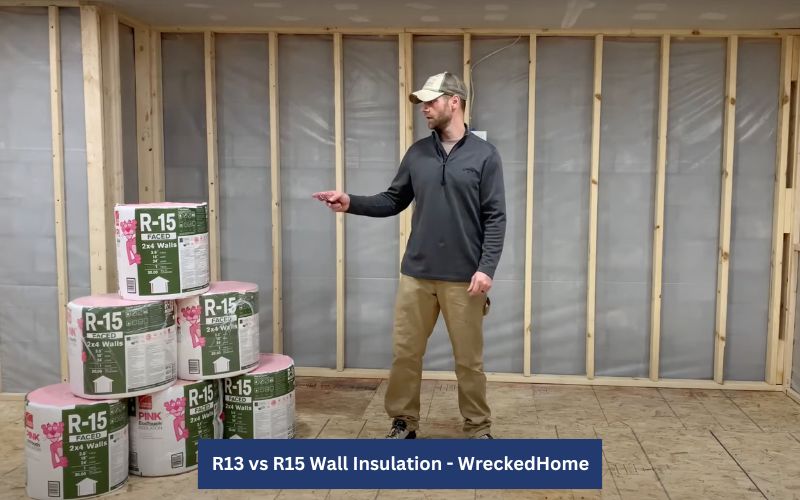
R13 vs R15 Wall Insulation – What’s the Best?
Announcing a winner between R13 vs R15 wall insulation is not possible. Both are efficient in working in different aspects. Mostly, your need for insulation makes any material with R value best for you. Sometimes, it works best for in those circumstances but cannot solve other’s issue. It also depends on your need of installation as R13 insulation is normally used in cavities of inner walls and here you cannot use R15. R15 is mostly used in basements, attics, floors, and external walls.
So, on a wider note, you can give R15 more points in terms of efficiency than R13.
What is R-value stacking?
R-value stacking is an interesting element in home insulation. It means you can add R values of previously installed insulation and the one being installed. It will help increase overall heat. For instance, if your house already has an insulation of R15 and you want to add one more layer of R3, you now have R18.
So, when you are building your house or remodeling for a new look, just keep this in mind and enjoy additional insulation.
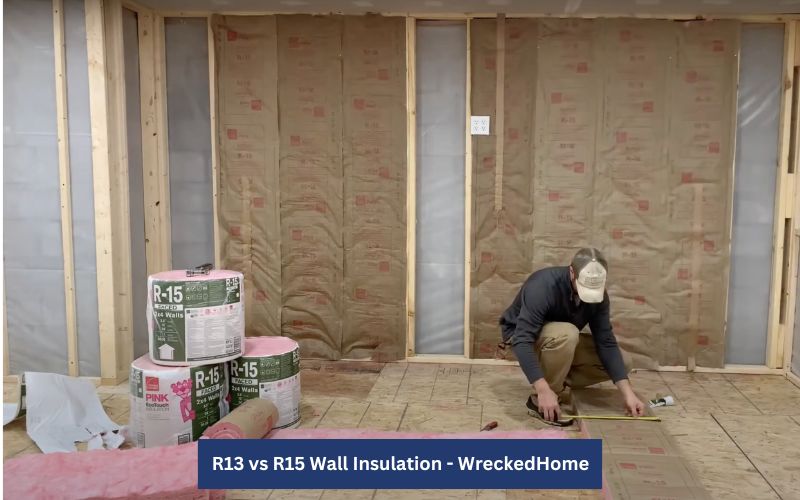
Conclusion – R13 vs R15 Wall Insulation
Homeowners confused in R value and their role in insulation must understand everything clear now. They now know better where to use R13 and what the role of R15 insulation is in their home. So, making homes secure with insulation is easy and versatile in this modern age. With this guide, we hope that your choice between R13 vs R15 wall insulation is a bit more simpler.
For any repairs, installations, builds, or questions; We recommend you to hire a professional. Find A Pro Near You Here!

